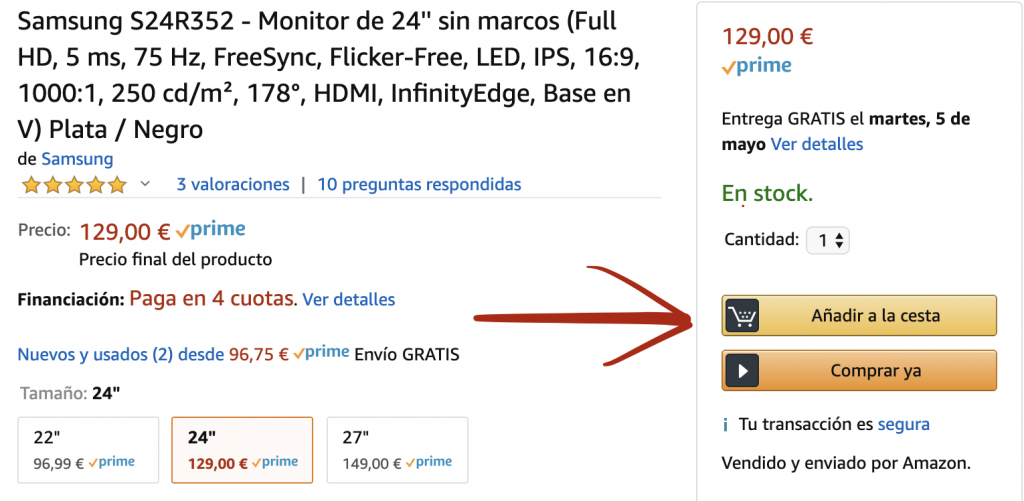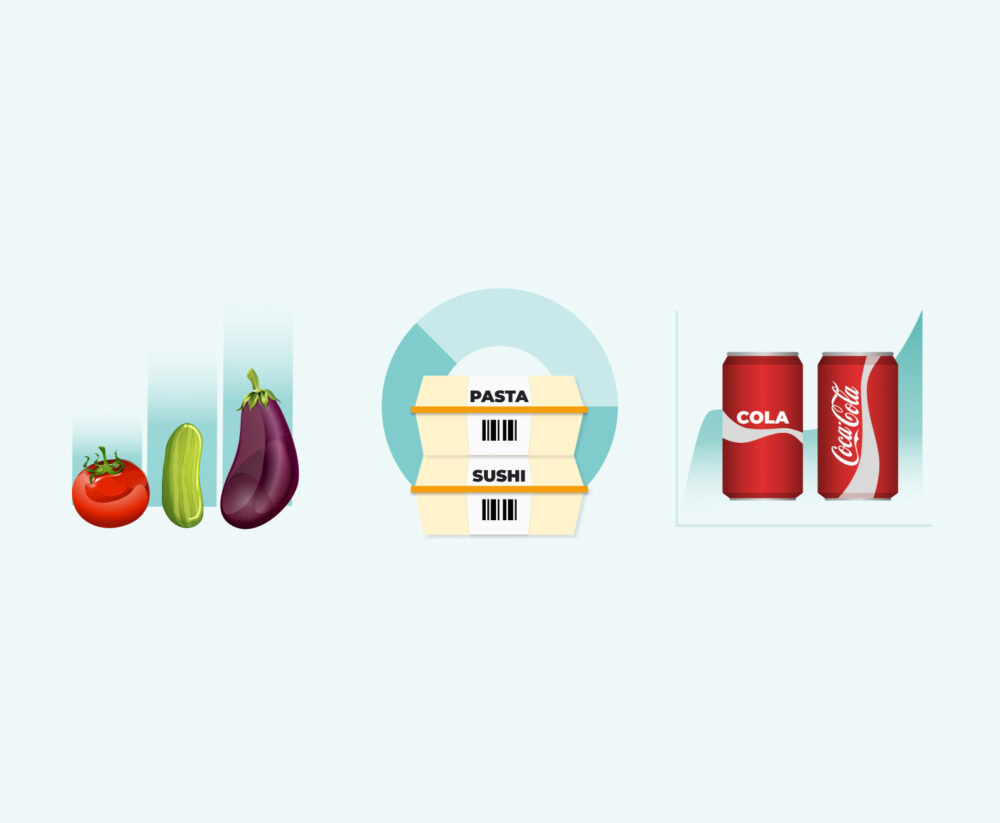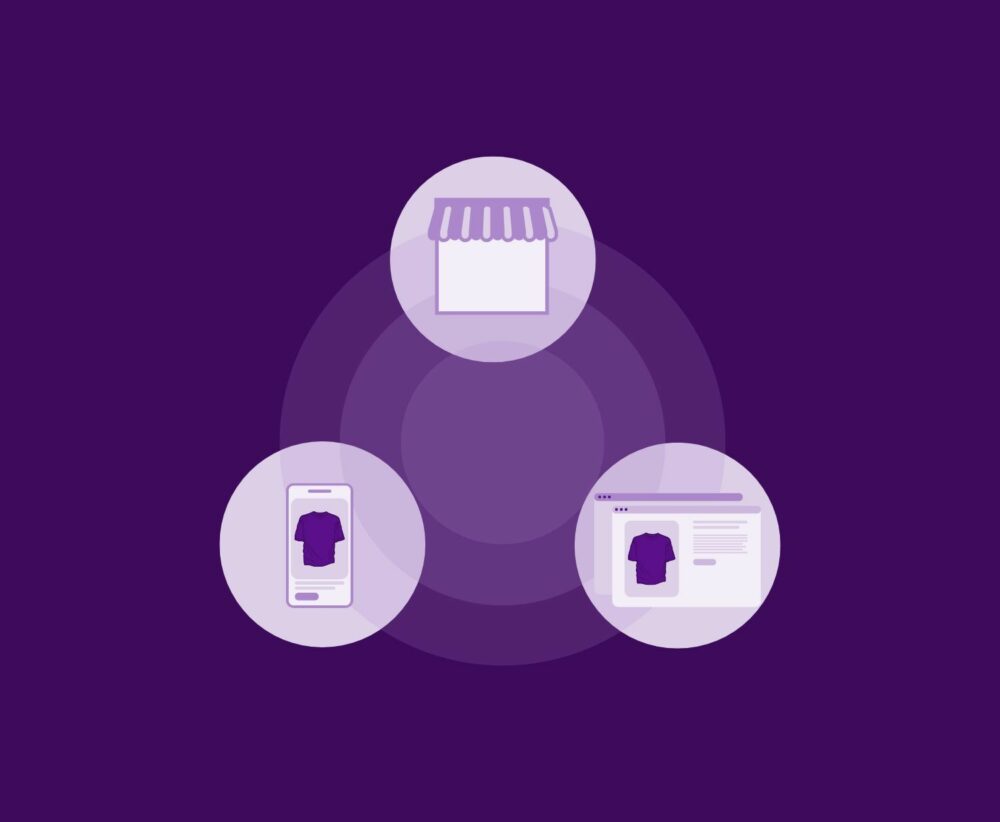Monitor prices on Amazon to win the Buy box
Amazon has millions of identical products sold by different manufacturers competing at the same time to appear in buyers’ search results. Some of these products have an advantage over the rest, which means they have won the Amazon Buy Box.
The Buy Box is the top right section of a product page where customers can add items to their cart or even make a purchase with a single click, as seen in this image.

82% of Amazon sales are made through the Buy Box. This percentage is even higher for mobile purchases because the box is right below the product image, so earning this position is a huge win for any Amazon seller.
Unfortunately, there is no guaranteed method of winning the Amazon Buy Box. Understanding the e-commerce giant’s algorithms and how to take advantage of them will increase your chances of staying ahead of the competition and securing the conversion rate bonus that the Buy Box provides.
How to be eligible for the Amazon Buy Box
To be eligible, you must meet the following requirements:
- Have a professional seller account.
- Sellers must be recognized as Buy Box eligible. You can find this information by logging into your Seller account. If you have multiple product categories, make sure to check eligibility for each category individually, as being eligible for one category does not imply eligibility for the others.
- Sell new items (used items have their own version of the Buy Box)
- Sellers must have products in stock. The Amazon algorithm favors sellers with items available, so even if you have won the Buy Box in previous occasions, it will rotate to another seller with adequate stock if yours runs out.
How to Win the Buy Box on Amazon
Amazon takes a number of factors into account when awarding the Buy Box to a seller. In most cases, the Buy Box is shared among several sellers, that is, your product can have 50% of the Buy Box and another competitor another 50%. In that case your product will appear 50% of the time.
Next we will see the factors that most influence when winning the Buy Box, from greater to lesser impact.
Fulfillment method
The fulfillment method used by third-party sellers has the greatest impact on winning the Buy Box.
There are three options: Fulfillment by Amazon (FBA), which allows marketplace sellers to store and ship items from Amazon warehouses; Fulfillment by Merchant (FBM); and Seller-Fulfilled Prime (SFP), which allows sellers to ship their orders from their own warehouses while still appearing for Prime customers.
It’s no surprise that FBA sellers have a better chance of winning the Buy Box knowing that Amazon rates its own fulfillment service as best in class when it comes to shipping times and on-time delivery rates. An FBM seller will need to be enrolled in SFP or have excellent scores in all other areas, as well as price significantly lower than the competition to outperform FBA sellers.
To be eligible for SFP, you must meet the following parameters for at least 30 consecutive days:
- Ratings greater than 4.5 stars.
- Package tracking code on 94% of Prime order deliveries.
- 95% on-time delivery rate on Prime orders.
- Less than 1% cancellation rate on Prime orders.
- Late shipment rate of less than 1% on all orders.
- Send in 24 or 48 hours.
- Use Amazon fulfillment for shipments
Final price
Total price the customer pays for your product including taxes and shipping. Having a low, competitive price increases your chances of winning the Buy Box, yes, but it’s not a guarantee. The impact of price on winning the Buy Box depends not only on the difference between your price and that of your competitors, but also on how your performance metrics vary compared to the competition.
For example, if you have better performance metrics than others, you can price higher than them and still earn part of the Buy Box. However, if your competitors have better performance metrics, you will have to decrease the price of the product with the consequent decrease in margin.
Shipping time
The speed at which you fulfill orders is another important measure that Amazon considers when determining which seller will win the Buy Box.
As a general rule, the faster you send, the better. And the best way to win the Buy Box is to match Amazon’s Prime delivery and ship orders to buyers within two days at most.
You must bear in mind that the shipping time influences more in some categories than in others. For example, if you sell perishable goods such as food, shipping time will have a greater impact.
Seller Ratings
While fulfillment method, final price, and shipping time are the most important factors for winning the Buy Box, the platform’s algorithm also considers other factors such as the seller’s feedback rating.
Reviews of your products
Similar to the previous point. It’s simple, Amazon likes to offer an excellent service, if customers have left good reviews on your products you will have more chances of opting for the Buy Box. Amazon takes into account the ratings you received in the last year, giving more importance to the most recent.
Customer response time
The time it takes to respond to your customers also matters. It is recommended to respond to your clients’ messages in less than 24 hours.
Defective order rate
A seller’s order defective rate, or ODR, is a measure of your ability to provide good customer service. Covers all orders with one or more defects represented as a percentage of total orders over the last 60 days.
Amazon measures three types of ODR:
- A-Z warranty claim rate, which are claims made by consumers when their orders are not satisfactory
- Credit card chargeback rate, which is the number of times a seller refunds customer orders
- To sell on Amazon, you must maintain an ODR below 1%. Third-party sellers (non-FBA) with an ODR exceeding 1% may have their accounts deactivated by Amazon.
Valid Tracking Rate
The valid tracking rate refers to the percentage of a seller’s orders that are shipped with proper tracking information during the last 30 days.
To increase the chances of winning a share of the Amazon Buy Box, sellers should aim for a perfect score of 100%. This means that all customers must receive the correct tracking information for their orders.
Delay rate and on-time delivery rate
Late rate and on-time delivery rate are the number of orders a seller ships after the expected ship date and the number of orders that ship on time in the last 30 days, respectively.
Third-party sellers should aim for a 0% late shipping rate and a 100% on-time delivery rate. However, you don’t have to maintain perfect scores on every one of these metrics. Sellers with a late delivery rate of less than 4% and an on-time delivery rate of more than 97% are also in good standing and can earn a share of the cash.
Catalog depth
Accurate inventory management may have a low impact on your chances of winning the Buy Box, but it remains important. Large, frequent fluctuations in inventory size can negatively affect your chances. And while items ordered in advance can win the Buy Box, Amazon’s algorithms favor sellers with consistently stocked and updated inventory.
Cancellation and refund fee
How often a seller cancels orders and how often buyers request refunds from a seller also affect the probability of winning the Buy Box, but the impact is smaller.
Still, non-FBA sellers should try to keep these percentages low. As a general rule of thumb, a churn rate of less than 2.5% is considered acceptable.
While metrics related to customer experience (cancellation and refund rate, catalog depth, on-time delivery rate, order defect rate, and average customer rating) are not as important in determining which seller wins the Buy Box, taken together, are important and Amazon will always favor third-party sellers with a better image, so sellers enrolled in FBA and Seller-Fulfilled Prime are more likely to earn a higher percentage of the Buy Box.
Pricing strategies to win the Amazon Buy Box:
Since price is a significant factor in winning the Buy Box, non-FBA sellers can focus on reducing product prices below those of their competitors. However, as noted above, lower prices do not always translate into a Buy Box profit and higher sales. There is more to consider when determining how and when to lower prices:
Manual product reassessment
This involves updating the price of each of your items within your seller’s account individually. While it may work for sellers who offer just a handful of products, those who sell dozens of items or are working to grow their business may find this method time consuming and unsustainable.
Set repricing rules
Another option to alter your prices to be more competitive for the Amazon Buy Box is to use rules-based pricing.
You can set up Amazon pricing rules from your Seller Central page to trigger an automatic price change when certain requirements are met. For example, you can create a rule that keeps your product price €1 below the Buy Box price.
However, there are also some drawbacks to this pricing method. For one thing, the rules are based on other sellers’ prices, so there are limited capabilities. Also, setting pricing rules can be time consuming and require regular updates because these rules can often contradict each other. On the other hand, establishing rule-based pricing can easily create price wars among sellers, which can decrease profits.
Using dynamic repricing
Dynamic repricing adjusts product prices in real time, reacting to variations in Amazon’s internal market such as competitor price changes or fluctuations in sellers’ inventory levels.
Amazon is more likely to feature sellers in the Buy Box who use dynamic repricing, despite having higher prices. According to a study by Northeastern University , at least 60% of sellers using dynamic repricing charge more for products than other sellers.
This data-centric approach to Amazon pricing returns higher profits to third-party sellers and requires less manual maintenance. Faced with catalogs with a high volume of references, it is unfeasible to set prices manually and even less so to do it optimally. Our competitor price monitoring technology allows you to carry out an analysis of the competition to set the prices of your catalog in an optimal and simple way.
Conclusions
The way Amazon gives relevance to some products over others works as a complex system, there is no sure way to guarantee that your product will appear in the position you want. However, you can dramatically increase your chances by focusing on the three most important factors: fulfillment method, shipping time, and final price.
By enrolling in FBA and ensuring your products are competitively priced and shipped swiftly, your chances of winning the Amazon Buy Box will undoubtedly increase.
If you are an individual and want to analyze the price evolution of some products you are interested in, there are some interesting options available. For example, this service allows you to analyze the price history of a product and configure alarms to receive notifications when a product drops in price.



